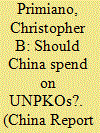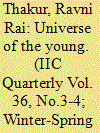|
|
|
Sort Order |
|
|
|
Items / Page
|
|
|
|
|
|
|
| Srl | Item |
| 1 |
ID:
141719


|
|
|
|
|
| Summary/Abstract |
This is a sociological analysis of empirical data regarding the alleged rising nationalism in contemporary China. Different from most of the studies of Chinese nationalism with a focus on the official and elite alike, as well as eye-catching nationalistic scenes, such as, pro-China demonstrations, this study adopts a micro-sociological approach and looks into how the forefront of China’s rising nationalism, the Chinese youth, engages with notions of nation and nationalism, and when, if at all, such notions become salient to them. Through this investigation, this article finds that the nation is not something students self-consciously engage themselves with between times of overt ‘hot’ nationalism display. So far from being fervent nationalists as has been suggested by some based on eye-catching nationalistic scenes, the forefront of China’s rising nationalism, the Chinese youth, neither actively (self-consciously) engages with nation and nationalism nor do they advance these to the highest political value as fervent nationalists do. Therefore, it is the contention of this article that the usual portrayal of a rising Chinese nationalism based on eye-catching nationalistic scenes overly exaggerates the degree to which the nation and nationalism are seriously and actively engaged by the Chinese people, especially the young Chinese who are supposed to be the most active social segment of the rising nationalism.
|
|
|
|
|
|
|
|
|
|
|
|
|
|
|
|
| 2 |
ID:
139956


|
|
|
|
|
| Summary/Abstract |
In March, David Shambaugh, a professor at George Washington University, wrote a major essay for the Wall Street Journal titled “The Coming Chinese Crackup.” Shambaugh’s main point was that “the endgame of Chinese communist rule has now begun . . . and it has progressed further than many think.” Shambaugh admits that his view is not universally accepted, but the fact that a scholar of his reputation has reached this conclusion is significant.
|
|
|
|
|
|
|
|
|
|
|
|
|
|
|
|
| 3 |
ID:
174410


|
|
|
|
|
| Summary/Abstract |
China has witnessed the rise of cohabitation and the delay of marriage among young people, but less attention has been paid to cohabitation as a process of living arrangement that may create new room to define gender roles or replicate conventional gender relations. Previous studies have debated on whether cohabitation is an egalitarian union with more symmetric bargaining power and individualistic pursuits, and this study sheds light on how young people in China negotiate their gender role ideologies in cohabiting unions. Based on in-depth interviews with 18 cohabiting couples in Guangzhou, Shenzhen, and nearby cities in South China, this study finds that men were more divided in their gender role ideologies and women were predominantly favorable toward egalitarian beliefs. In the “intended egalitarian” couples, both partners supported egalitarian ideals and reported sharing housework equally, which served men’s family-oriented masculinity and women’s individualistic pursuits and self-development. In the “discordant” couples, with a typical “traditional man and egalitarian woman” combination, traditional men were more defensive than egalitarian women. Most discordant couples adopted traditional arrangements, and only a few traditional men tolerated egalitarian arrangements as “temporary” due to their unemployed status or other real-life constraints. Both the celebration of egalitarian ideals in some couples and the persistence of traditional arrangements in others reflect the mixed and uneven trends of gender equalization in the reform-era China.
|
|
|
|
|
|
|
|
|
|
|
|
|
|
|
|
| 4 |
ID:
092419


|
|
|
|
|
| Publication |
2009.
|
| Summary/Abstract |
There are only a few Chinese families settled in North Bengal, concentrated in the towns of Siliguri and Kalimpong. The Chinese have on an average been a literate community but few of them continued for post-secondary education. The reasons were that many of them were engaged in business at an early age which was much more lucrative and on the other hand some people were struggling to maintain their establishment. Economic challenges left little time and recourses to concentrate on education. However, since the community has prospered and with time, parents increasingly opt to send their children to school. These days, the occupational needs of the Chinese youth in North Bengal can be divided into two categories, either to migrate abroad or to be a successful businessman. It is perceptible that Chinese in India are conscious with regard to the education of their children. English-medium schools are the preferred institutions and for this the Chinese have adopted another strategy-that of conversion to Christianity. Since Christians have some concessions in the admission process, in Convent schools, many Chinese see conversion as a solely utilitarian issue
|
|
|
|
|
|
|
|
|
|
|
|
|
|
|
|
| 5 |
ID:
161515


|
|
|
|
|
| Summary/Abstract |
Using a mixed-methods approach, this article surveys and compares how Chinese youth view China’s rise with how their Asian counterparts do. The quantitative analysis uses data from the Asian Student Survey to identify the differences in perception of China’s rise between Chinese and Asian youth. Qualitative interviewing is undertaken to probe and assess the reasons behind the gap. The results show that Chinese youth are more optimistic about political stability and nationalism accompanying China’s rise. Nevertheless, they are open to acknowledge a variety of social problems in the wake of economic growth. With regard to China’s international influence, most Chinese youth have a firm faith in China’s peaceful rise, but they also perceive threats from other countries that are normally ignored in the China threat thesis. Chinese youth tend to attribute the negative evaluations of China among Asian counterparts to external reasons rather than see them as reflections of China’s ‘problematic’ foreign policy. Interview materials show why and how Chinese foreign policy is justified among Chinese young people. They open a door for outsiders to understand Chinese public opinion toward international politics.
|
|
|
|
|
|
|
|
|
|
|
|
|
|
|
|
| 6 |
ID:
120634


|
|
|
| 7 |
ID:
163380


|
|
|
|
|
| Summary/Abstract |
When China joined the United Nations in 1971, it viewed UN peacekeeping operations (UNPKOs) as an instrument for powerful countries to exploit weaker countries. Today, under Xi Jinping, China contributes the largest number of UN peacekeeping personnel among the five permanent (P5) members of the UN Security Council. This article presents findings from a pilot study based on a survey conducted at two international universities in China in the fall of 2016, regarding how Chinese students perceive China’s UNPKO involvement. A total of 297 Chinese university students participated in this survey. Given that there has been little scholarship on how Chinese citizens view China’s UNPKO spending or involvement, this article aims to contribute to our understanding of this subject.
|
|
|
|
|
|
|
|
|
|
|
|
|
|
|
|
| 8 |
ID:
189057


|
|
|
|
|
| Summary/Abstract |
Since 2012, Beijing has been promoting a strain of populist nationalism which underscores both the institutional superiority of the ruling party and the cultural superiority of being Chinese. At the international level, however, the image of both the regime and the Chinese has been marred due to the coronavirus (COVID-19) outbreak in Wuhan (December 2019–January 2020). This study examines the extent and the form that the surge in nationalist sentiment of Chinese young people has taken during the COVID-19 pandemic. Based on a questionnaire survey of 1,200 students from a sample of 20 colleges/universities in China (June–July 2020), this study shows that the respondents express high satisfaction with the state's performance in tackling the pandemic, and that there is a substantial surge of nationalist sentiment with a high level of hostility towards other nations (e.g. the United States). Such nationalist sentiment, however, is found to express a bifurcated pattern in that young Chinese also tend to embrace the opportunity to work and study in the Western societies they ostensibly dislike.
|
|
|
|
|
|
|
|
|
|
|
|
|
|
|
|
| 9 |
ID:
128519


|
|
|
|
|
|
|
|